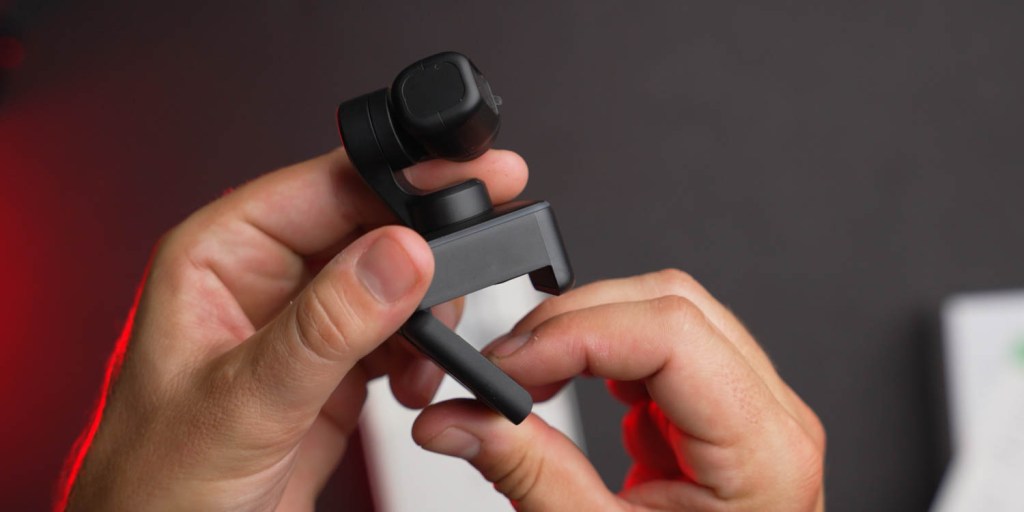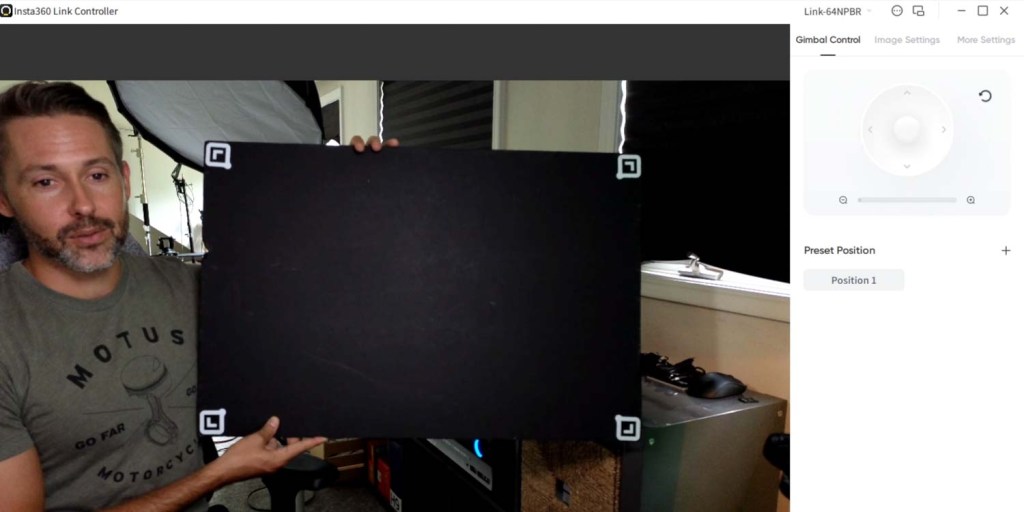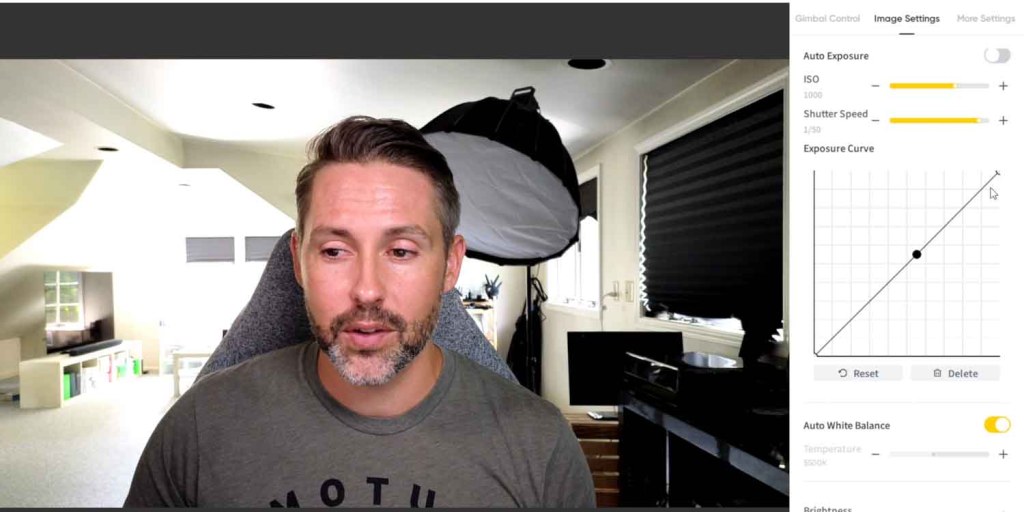
The new Insta360 Link webcam may not look like the traditional shape we’re used to, but that’s because it’s an AI-powered, three-axis gimbal-stabilized 4K camera. This thing is packed with features that will appeal to streamers, content creators, and work professionals. Be sure to hit the video below to see and hear a deep dive into everything this $300 webcam is capable of.
Design
The first thing that surprised me was how compact the Insta360 Link camera is – especially when compared to the Razer Kiyo Pro. The base is hefty, and it feels solid but it doesn’t take up much room on top of a monitor.
The camera lens is mounted on a small three-axis gimbal that stabilizes the lens but also allows powerful AI control. When powered on and the tracking mode is enabled, the camera will follow a subject around the frame. This can easily be turned off, though, and adjustments can be made to the camera manually to get the framing right.
Around the base is a glowing ring that will light up to indicate when the camera is turned on, tracking gesture-controlled AI inputs, and other useful information. One example is to hold up a palm to the camera and when the Insta360 Link detects it, the base will flash blue indicating it is now in tracking mode.
While the Link camera doesn’t have a lens cover for privacy, after 10 seconds in standby mode, the camera will point straight down to enter a sort of self-privacy mode.

Insta360 Link: Effortless setup
Setting up the Insta360 Link is simple and it works just fine without the software. The built-in monitor stand is simple to operate and sits securely on the top of a screen. Alternatively, you can add a tripod via the threads on the bottom.
Installing and opening the Insta360 Link Controller application unlocks plenty of control for the Link Camera. More info on that is below.
Insta360-Link: Video
Shooting modes
With a gimbal-stabilized webcam, Insta360 has developed different shooting modes. The Link Camera can stay static, track a moving subject, focus on a whiteboard with the included tracking stickers, enter a desk view mode, or shoot top-down. Switching between some of these modes can be activated with AI-powered gestures like waving to the camera, but for top-down and desk view modes, the Link Controller app needs to be powered up.

Image quality
With a resolution of up to 4K at 30FPS, the image coming from the Insta360 Link is very sharp. It can also do higher frame rates if needed. At 1080p, the Link can go up to 60FPS.
Beyond sharpness, the ½-inch sensor also gets a decent amount of bokeh, or background blurring, when the subject is relatively close to the camera. It’s not as good as a dedicated DSLR or mirrorless camera with a larger sensor and fast lens, but it is commendable for a webcam.

It also shines in low-light situations. It might be best with a key light on your face, but even when just illuminated by my monitor, the Insta360 Link webcam looked great.
One other major benefit of the gimbal design is that the image is stabilized and minimizes camera shake from desk movement. In the past with other cameras, there have been times where the image gets a bit shaky from a webcam being mounted on top of a monitor and desk movements being transferred to the camera. Thanks to the three-axis gimbal, though, this was never an issue with the Link camera.
For tricky lighting scenarios, the Link Camera also has an HDR mode. This kind of smooths out the balance between shadows and highlights to help when lighting isn’t ideal. If you have a good light source on your face I don’t think this mode will be necessary, but it’s nice to have when lighting isn’t ideal. HDR mode also limits the resolution to 1080p at 30fps.
The only issue I had was when using 4K in OBS, the image was a bit delayed. The audio still came through on time, but the picture was nearly a second behind the audio. That wasn’t an issue when using the Link Controller software but only happened in OBS.

Rock-solid autofocus
Another highlight of the Insta360 Link is the autofocus performance, which it calls True Focus. Both fast and accurate, True Focus is some of the best I’ve seen in a webcam. Link uses phase detection autofocus. Granted, it’s more expensive than the Logitech StreamCam and Razer Kiyo Pro, but the price seems to be justified with the performance bump.
Image control via Link Controller app
While the camera works great straight out of the box without the included software, opening up Insta360 Link Controller enables deep control of the camera and image. From the home screen, there are controls for entering the different view modes like desk, overhead, whiteboard, and tracking.
Over on the right is a control panel with three tabs. First up is the gimbal control tab for tilting the camera as well as setting preset positions.
Secondly, the image settings tab controls exposure, white balance, and other color options. Personally, I think the Link looks great in the default auto modes but if adjustments are necessary, they are easy to make from this panel.

Lastly is the more settings tab. In here are controls for gesture settings. The Link camera can recognize gestures to enable the tracking mode, whiteboard mode, or zoom the camera, but these can also be disabled.
Further down is an AI zoom setting that will keep a head, half body, or whole body in the frame when tracking is enabled.
Next up are settings for anti-flicker, tracking speeds, and autofocus. Further down are toggles for streamer mode, HDR, mirror image, and firmware versions.
For capturing video in a portrait orientation, first, enable the streamer mode in the more settings tab and then select the 9:16 resolution desired from the drop-down menu. The camera will orient itself into a vertical format. For streamers, this means the image doesn’t have to be cropped to fit a certain style. It also still tracks just as well when the mode is enabled. For the best experience, Insta360 recommends mounting the camera on a tripod and tilting the camera horizontally.

Insta360 Link: AI control
AI control is one of the biggest features of the Insta360 Link Camera and almost everything works well in my experience.
AI tracking modes kept me in the frame no matter how far I moved unless I did some ridiculously fast back-and-forth movements to try and trick it. Under normal circumstances, though, it performed well.
Top-down and desk view modes are also easy to enable and work well. The desk view mode automatically flips the camera image so that text is right side up and viewable for others. It also distorts the image a bit to make documents look square in the camera. This can make some other objects look a little funky, but it really is meant for viewing documents.
Whiteboard mode will identify the tracking squares in the frame and lock the image onto the board. For presentations, this is a great way to get viewers to focus on the board and with a simple peace sign gesture return to a wider image.

Noise-cancelling Mic
The microphone is also impressive. With an AC unit running in my office, the Link could knock out much of the background distractions with its dual noise-cancelling mics. I recorded the entire review with the Insta360 Link microphone without any effects so be sure to give it a watch to hear how it sounds.
gadgetnewsonline’ Take
While it may be expensive compared to some webcams, the Insta360 Link is by far the best webcam that I’ve used. The combination of clear image, solid autofocus, and accurate color make for a solid webcam themselves but adding in a gimbal-stabilized camera with AI-tracking and gesture-controlled shooting modes takes it to a whole new level. If you need to take a stream or presentation to the next level, the Insta360 Link appears to deliver in spades.
Buy Insta360 Link
FTC: We use income earning auto affiliate links. More.




Comments